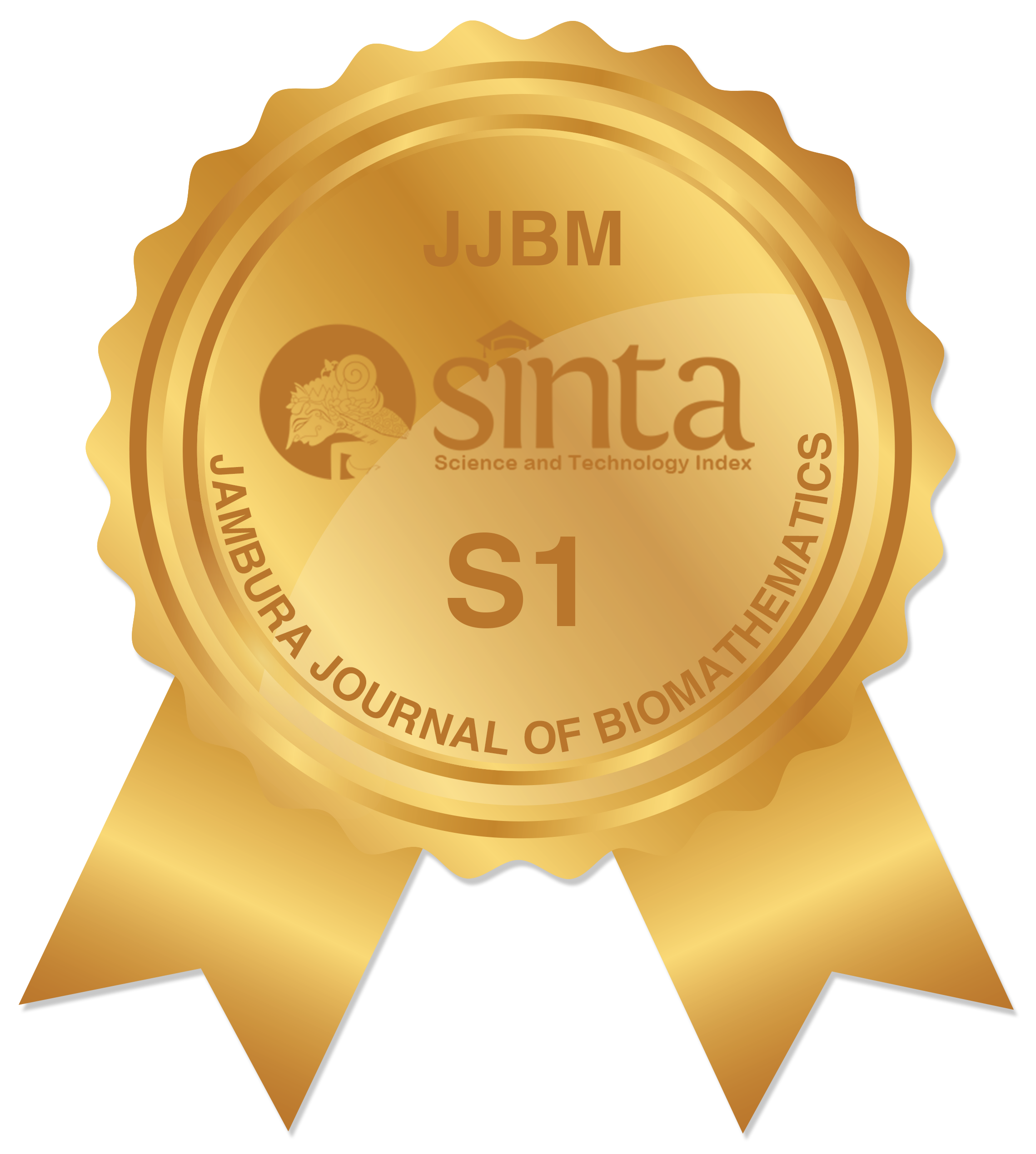Forward and Backward Bifurcation Analysis From an Imperfect Vaccine Efficacy Model With Saturated Treatment and Saturated Infection
Abstract
Keywords
Full Text:
PDFReferences
H. R. Pandey et al., "Analysis of dengue infection transmission dynamics in nepal using fractional order mathematical modeling" Chaos, Solitons & Fractals: X, vol. 11, p. 100098, 2023. DOI:10.1016/j.csfx.2023.100098
D. Aldila et al., "Unraveling dengue dynamics with data calibration from palu and jakarta: Optimizing active surveillance and fogging interventions" Chaos, Solitons & Fractals, vol. 189, p. 115729, 2024. DOI:10.1016/j.chaos.2024.115729
P. R. Murugadoss et al., "Analysis of dengue transmission dynamic model by stability and hopf bifurcation with two-time delays" Frontiers in Bioscience-Landmark, vol. 28, no. 6, 2023. DOI:10.31083/j.fbl2806117
M. Z. Ndii et al., "Numerical simulations of a two-strain dengue model to investigate the efficacy of the deployment of wolbachia-carrying mosquitoes and vaccination for reducing the incidence of dengue infections" Journal of Biosafety and Biosecurity, vol. 6, no. 4, pp. 244-251, 2024. DOI:10.1016/j.jobb.2024.08.003
A. Raza et al., "Discussion on vector control dengue epidemic model for stability analysis and numerical simulations" Brazillian Journal of Physics, vol. 55, no. 1, p. 21, 2025. DOI:10.1007/s13538-024-01656-y
I. H. Febiriana, A. H. Hassan, and D. Aldila, "Enhancing malaria control strategy: Optimal control and cost-effectiveness analysis on the impact of vector bias on the efficacy of mosquito repellent and hospitalization" Journal of Applied Mathematics, vol. 2024, no. 1, p. 9943698, 2024. DOI:10.1155/2024/9943698
H. Tasman et al., "Assessing the impact of relapse, reinfection and recrudescence on malaria eradication policy: a bifurcation and optimal control analysis" Tropical Medicine and Infectious Disease, vol. 7, no. 10, p. 263, 2022. DOI:10.3390/tropicalmed7100263
B. D. Handari et al., "An optimal control model to understand the potential impact of the new vaccine and transmission-blocking drugs for malaria: A case study in papua and west papua, indonesia" Vaccines, vol. 10, no. 8, p. 1174, 2022. DOI:10.3390/vaccines10081174
J. N. Ndam and P. O. Azike, "Analysis of the transmission dynamics and effects of containment strategies on the eradication of malaria" Scientific African, vol. 25, p. e02306, 2024. DOI:10.1016/j.sciaf.2024.e02306
R. Seck et al., "An age-structured mathematical model for studying malaria transmission dynamics: Applications to some areas of senegal" Mathematics and Computers in Simulation, vol. 229, pp. 392-408, 2025. DOI:10.1016/j.matcom.2024.10.006
C. K. Mahadhika and D. Aldila, "A deterministic transmission model for analytics-driven optimization of covid-19 post-pandemic vaccination and quarantine strategies" Mathematical Biosciences and Engineering, vol. 21, no. 4, pp. 4956-4988, 2024. DOI:10.3934/mbe.2024219
D. Aldila et al., "A mathematical study on the spread of covid-19 considering social distancing and rapid assessment: The case of jakarta, indonesia" Chaos, Solitons & Fractals, vol. 139, p. 110042, 2020. DOI:10.1016/j.chaos.2020.110042
K. Chen et al., "Dynamics of an sveir transmission model with protection awareness and two strains" Infectious Disease Modelling, vol. 10, no. 1, pp. 207-228, 2025. DOI:10.1016/j.idm.2024.10.001
R. I. Gweryina, C. E. Madubueze, and M. A. Nwaokolo, "Mathematical modelling and control of covid-19 transmission in the presence of exposed immigrants" Communication in Biomathematical Sciences, vol. 4, no. 2, pp. 93-105 2021. DOI:10.5614/cbms.2021.4.2.2
M. H. Biswas et al., "Modelling the effect of self-immunity and the impacts of asymptomatic and symptomatic individuals on covid-19 outbreak" Computer Modeling in Engineering & Sciences, vol. 125, no. 3, pp. 1033-1060, 2020. DOI:10.32604/cmes.2020.012792
A. Din et al., "Mathematical analysis of spread and control of the novel corona virus (covid-19) in china" Chaos, Solitons and Fractals, vol. 141, p. 110286, 2020. DOI:10.1016/j.chaos.2020.110286
G. Simorangkir et al., "Mathematical model of tuberculosis considering observed treatment and vaccination interventions" Journal of Interdisciplinary Mathematics, vol. 24, no. 6, pp. 1717-1737, 2021. DOI:10.1080/09720502.2021.1958515
M. L. Olaosebikan, M. K. Kolawole, and K. A. Bashiru, "Transmission dynamics of tuberculosis model with control strategies" Jambura Journal of Biomathematics, vol. 4, no. 2, pp. 110-118, 2023. DOI:10.37905/jjbm.v4i2.21043
E. D. A. Ginting, D. Aldila, and I. H. Febiriana, "A deterministic compartment model for analyzing tuberculosis dynamics considering vaccination and reinfection" Healthcare Analytics, vol. 5, p. 100341, 2024. DOI:10.1016/j.health.2024.100341
R. K. MA, S. Sugiarto, and S. Nurwijaya, "Dynamical system for tuberculosis outbreak with vaccination treatment and different interventions on the burden of drug resistance" Jambura Journal of Biomathematics, vol. 5, no. 1, pp. 10-18, 2024. DOI:10.37905/jjbm.v5i1.21903
D. Aldila et al., "On the role of early case detection and treatment failure in controlling tuberculosis transmission: A mathematical modeling study" Communication in Biomathematical Sciences, vol. 7, no. 1, pp. 61-86, 2024. DOI:10.5614/cbms.2024.7.1.4
D. Aldila et al., "Improving tuberculosis control: assessing the value of medical masks and case detection"”a multi-country study with cost-effectiveness analysis" Royal Society Open Science, vol. 11, no. 6, 2024. DOI:10.1098/rsos.231715
D. Aldila et al., "A tuberculosis epidemic model as a proxy for the assessment of the novel m72/as01e vaccine" Communications in Nonlinear Science and Numerical Simulation, vol. 120, p. 107162, 2023. DOI:10.1016/j.cnsns.2023.107162
O. J. Peter et al., "Optimizing tuberculosis control: a comprehensive simulation of integrated interventions using a mathematical model" Mathematical Modelling and Numerical Simulation with Applications, vol. 4, no. 3, pp. 238-255, 2024. DOI:10.53391/mmnsa.1461011
S. Majee, S. Jana, and T. K. Kar, "Dynamical analysis of monkeypox transmission incorporating optimal vaccination and treatment with cost-effectiveness" Chaos, vol. 33, no. 4, 2023. DOI:10.1063/5.0139157
I. Smouni et al., "Mathematical modeling and analysis of a monkeypox model" Communications in Mathematical Biology and Neuroscience, vol. 2023, 2023. DOI:10.28919/cmbn/8076
M. Zevika, A. Triska, and J. W. Puspita, "The dynamics of monkeypox transmission with an optimal vaccination strategy through a mathematical modelling approach" Computer Research and Modeling, vol. 15, no. 6, pp. 1635-1651, 2023. DOI:10.20537/2076-7633-2023-15-6-1635-1651
A. E. Mansouri et al., "Mathematical modeling and optimal control strategy for the monkeypox epidemic" Mathematical Modeling and Computing, vol. 10, no. 3, pp. 944-955, 2023. DOI:10.23939/mmc2023.03.944
M. M. Al-Shomrani, S. S. Musa, and A. Yusuf, "Unfolding the transmission dynamics of monkeypox virus: An epidemiological modelling analysis" Mathematics, vol. 11, no. 5, p. 1121, 2023. DOI:10.3390/math11051121
M. A. Stephano, M. M. Mayengo, and J. I. Irunde, "The role of asymptomatic carriers on the dynamics of a lymphatic filariasis model incorporating control strategies" Results in Control and Optimization, vol. 15, p. 100425, 2024. DOI:10.1016/j.rico.2024.100425
D. Aldila et al., "Optimal control of pneumonia transmission model with seasonal factor: Learning from jakarta incidence data" Heliyon, vol. 9, no. 7, p. e18096, 2023. DOI:10.1016/j.heliyon.2023.e18096
M. A. Khan et al., "Dynamic behavior of leptospirosis disease with saturated incidence rate" International Journal of Applied and Computational Mathematics, vol. 2, no. 4, pp. 435-452, 2016. DOI:10.1007/s40819-015-0102-2
D. Baca-Carrasco, D. Olmos, and I. Barradas, "A mathematical model for human and animal leptospirosis" in Journal of Biological Systems, vol. 23, no. supp01, pp. S55-S65, 2015. DOI:10.1142/S0218339015400057
G. Zaman et al., "Modeling dynamical interactions between leptospirosis infected vector and human population" Applied Mathematical Sciences, vol. 6, no. 26, pp. 1287-1302, 2012.
M. A. Khan et al., "Prevention of leptospirosis infected vector and human population by multiple control variables" Abstract and Applied Analysis, vol. 2014, pp. 1-9, 2014. DOI:10.1155/2014/619035
O. Diekmann, J. A. Heesterbeek, and J. A. Metz, "On the definition and the computation of the basic reproduction ratio r0 in models for infectious diseases in heterogeneous populations" Journal of Mathematical Biology, vol. 28, no. 4, 1990. DOI:10.1007/BF00178324
A. B. Gumel, "Causes of backward bifurcations in some epidemiological models" Journal of Mathematical Analysis and Applications, vol. 395, no. 1, pp. 355-365, 2012. DOI:10.1016/j.jmaa.2012.04.077
O. Sharomi et al., "Mathematical analysis of the transmission dynamics of hiv/tb co-infection in the presence of treatment" Mathematical Biosciences and Engineering, vol. 5, no. 1, pp. 145-174, 2008. DOI:10.3934/mbe.2008.5.145
A. M. Niger and A. B. Gumel, "Mathematical analysis of the role of repeated exposure on malaria transmission dynamics" Dyn. Syst. Differ. Equ., vol. 16, no. 3, pp. 251-287, 2008. DOI:10.1007/s12591-008-0015-1
D. Okuonghae, "Backward bifurcation of an epidemiological model with saturated incidence, isolation and treatment functions" Qualitative Theory of Dynamical Systems, vol. 18, no. 2, pp. 413-440, 2019. DOI:10.1007/s12346-018-0293-0
O. Diekmann, J. Heesterbeek, and M. G. Roberts, "The contruction of next-generation matrices for compartmental epidemic models" Journal of The Royal Society, vol. 7, no. 47, pp. 873-885, 2010. DOI:10.1098/rsif.2009.0386
C. Castillo-Chavez and B. Song, "Dynamical models of tuberculosis and their applications" Mathematical Biosciences and Engineering, vol. 1, no. 2, pp. 361-404, 2004. DOI:10.3934/mbe.2004.1.361
S. H. Strogatz, Nonlinear Dynamics and Chaos: With Applications to Physics, Biology, Chemistry, and Engineering, CRC Press, Boca Raton, 2018.
B. P. Statistik, "[metode baru] umur harapan hidup saat lahir (uhh) (tahun), 2022-2024" 2024, https://www.bps.go.id/id/statistics-table/2/NDE0IzI=/-metode-baru-umur-harapan-hidup-saat-lahir-uhh-.html, accessed on 28 Jananuary 2025.
DOI: https://doi.org/10.37905/jjbm.v5i2.28810
Copyright (c) 2024 Hakan Ahmad Fatahillah, Dipo Aldila

This work is licensed under a Creative Commons Attribution-NonCommercial 4.0 International License.
Jambura Journal of Biomathematics (JJBM) has been indexed by:
EDITORIAL OFFICE OF JAMBURA JOURNAL OF BIOMATHEMATICS |
 | Department of Mathematics, Faculty of Mathematics and Natural Science, Universitas Negeri Gorontalo Jl. Prof. Dr. Ing. B. J. Habibie, Moutong, Tilongkabila, Kabupaten Bone Bolango 96554, Gorontalo, Indonesia |
 | Email: [email protected] |
 | +6281356190818 (WA Only) |
 | Jambura Journal of Biomathematics (JJBM) by Department of Mathematics Universitas Negeri Gorontalo is licensed under a Creative Commons Attribution-NonCommercial 4.0 International License. Powered by Public Knowledge Project OJS. |
















